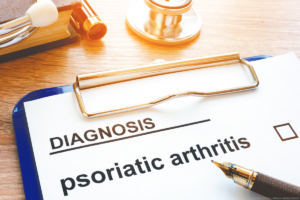 BALTIMORE—Approximately 30% of patients with psoriasis are estimated to be affected by psoriatic arthritis (PsA).1 Why do some patients develop PsA while others don’t? A session at the 19th Annual Johns Hopkins Advances in the Diagnosis and Treatment of Rheumatic Diseases Symposium titled Psoriatic Arthritis: Scientific Principles and Therapeutic Landscapes provided a wide array of insights into this question and a host of others.
BALTIMORE—Approximately 30% of patients with psoriasis are estimated to be affected by psoriatic arthritis (PsA).1 Why do some patients develop PsA while others don’t? A session at the 19th Annual Johns Hopkins Advances in the Diagnosis and Treatment of Rheumatic Diseases Symposium titled Psoriatic Arthritis: Scientific Principles and Therapeutic Landscapes provided a wide array of insights into this question and a host of others.
Pathology
The lecture was presented by Christopher Ritchlin, MD, MPH, professor of medicine, Center for Musculoskeletal Research, Allergy, Immunology and Rheumatology Division, University of Rochester, N.Y.
Dr. Ritchlin discussed work from Ogdie et al., which demonstrated that most patients with PsA have more than one domain involved. In many patients, the disease will manifest in myriad ways, including with peripheral arthritis, skin psoriasis, nail psoriasis, axial disease, enthesitis and dactylitis. Using data from patients enrolled in the Corrona PsA/Spondyloarthritis Registry, researchers found about 27% of patients have two domains of disease, 22% have three domains and 11% have four domains.2 These findings are important because success in treating PsA relies on identifying how the disease affects a specific patient. Patient care also requires understanding the effect treatment strategies may have on the domain(s) of disease in question.

Dr. Ritchlin
Before evaluating the clinical manifestations of PsA, we should seek to understand its pathobiology, noted Dr. Ritchlin. Recently in Nature Reviews Immunology, Kingston H. G. Mills, professor of Experimental Immunology, Biochemistry at Trinity College, Dublin, and director of the Trinity Biomedical Sciences Institute, provided an elegant explanation of the role of interleukin (IL) 17 and cells that produce IL-17 in both protection and pathology in people. IL-1ß and IL-23 induce production of IL-17A and IL-17F, which provide protective immunity against bacteria and fungi by promoting neutrophil recruitment, enhancing barrier function and producing antimicrobial peptides.3 When dysregulation of the IL-17 system occurs, immunopathology may result in chronic inflammation and autoimmunity. Thus, it’s logical that monoclonal antibodies directed against IL-17, IL-17A, IL-17F, the IL-17 receptor and IL-23 may be effective to treat patients with PsA.
Microbiome: The microbiome has received a fair amount of attention in the world of autoimmunity, and PsA is no exception. The recognition that psoriasis, PsA and inflammatory bowel disease frequently co-occur lends credence to the theory that intestinal health is involved in the development of all these diseases.
Theories for the role of the gut microbiome in the pathogenesis of psoriasis and PsA include issues related to altered immune homeostasis, intestinal permeability and imbalance of short- and medium-chain fatty acid-producing bacteria.4 Dr. Ritchlin summarized a few ways in which it would be possible to effectively alter the gut microbiome, including via fecal transplant, nutraceuticals, anti-inflammatory diets, pre- and pro-biotics, and bacteria and fungi that release anti-inflammatory compounds.
Treatment
Dr. Ritchlin discussed studies that provide valuable insights for practicing rheumatologists. Regierer et al. evaluated 1,300 patients with PsA given a new biologic or targeted synthetic disease-modifying anti-rheumatic drug (tsDMARD)—some with concomitant methotrexate and others without. Their study showed that only 45% of patients remained on the same biologic DMARD or tsDMARD at 12 months.5 This finding indicates that retention on biologic DMARD or tsDMARD therapy for patients with PsA remains poor and concurrent use of methotrexate may not help.
Other important treatment topics Dr. Ritchlin discussed included how central pain sensitization syndromes are common in patients with PsA and may influence disease activity measures. He also noted that, on average, women with PsA may be less likely to achieve treatment response outcomes even with treat-to-target approaches.
Axial Disease
On the subject of axial disease in PsA, Dr. Ritchlin highlighted similarities and differences found in patients with ankylosing spondylitis.
Jadon et al. performed a prospective cross-sectional study of more than 200 patients with PsA and 200 patients with ankylosing spondylitis in Bath, U.K. They found 43% of patients with radiographic evidence of axial disease had PsA. Among these patients, axial disease was symptomatically silent in 25%. Twenty-four percent of patients with PsA fulfilled the Modified New York criteria for ankylosing spondylitis, and 33% of patients with PsA had spondylitis without sacroiliitis on imaging. Finally, although disease activity, metrology and disability in PsA axial disease were comparable with those with ankylosing spondylitis, radiographic axial disease was more severe in ankylosing spondylitis than PsA.6
These findings provide helpful insights into features that may indicate when and how clinicians can look for spondylitis in patients with PsA.
Remission
Dr. Ritchlin concluded his talk by discussing the potential for using combination therapies to achieve disease remission in PsA. This somewhat radical approach comes from the field of gastroenterology, in which some studies combined medications, such as guselkumab and golimumab, in the treatment of moderate to severe ulcerative colitis. Such work seems to indicate that IL-23 and tumor necrosis factor inhibition may yield synergistic benefit via suppression of pro-inflammatory and increase in anti-inflammatory, gene expression.7
Therapies in the pipeline include anti-IL-17 treatments, such as bimekizumab, sonelokumab and izokibep, and IL-23 inhibition with such agents as tildrakizumab, deucravacitinib and brepocitinib. Janus kinase (JAK) inhibitors may also be a potential treatment for patients with PsA. However, these agents carry a black box warning from the U.S. Food & Drug Administration (FDA) about the potential for increased risk of serious infections, mortality, malignancy, major adverse cardiovascular events and thrombosis. Thus, patient selection for such treatment must be thoughtful.
Just as PsA is multi-faceted, so too was Dr. Ritchlin’s lecture. He sought to help the audience understand the underlying mechanisms of the immune system that promote disease activity and the latest research on how to optimize therapy.
Many organizations have created guidelines for the management of PsA, such as the ACR and the National Psoriasis Foundation, the Group for Research and Assessment of Psoriasis and Psoriatic Arthritis and EULAR. Each set of guidelines must be understood in the context of the data on which it was constructed. In his lecture, Dr. Ritchlin helped rheumatologists understand this information and how to make informed decisions on the part of their patients with PsA.
Jason Liebowitz, MD, is an assistant professor of medicine in the Division of Rheumatology at Columbia University Vagelos College of Physicians and Surgeons, New York.
References
- Mease PJ, Gladman DD, Papp KA, et al. Prevalence of rheumatologist-diagnosed psoriatic arthritis in patients with psoriasis in European/North American dermatology clinics. J Am Acad Dermatol. 2013 Nov;69(5):729–735.
- Ogdie A, Hur P, Liu M, et al. Effect of multidomain disease presentations on patients with psoriatic arthritis in the Corrona Psoriatic Arthritis/Spondyloarthritis Registry. J Rheumatol. 2021 May;48(5):698–706.
- Mills KHG. IL-17 and IL-17-producing cells in protection versus pathology. Nat Rev Immunol. 2023 Jan;23(1):38–54.
- Myers B, Brownstone N, Reddy V, et al. The gut microbiome in psoriasis and psoriatic arthritis. Best Pract Res Clin Rheumatol. 2019 Dec;33(6):101494.
- Regierer A, Kiefer D, Schett G, et al. PsA patients receiving monotherapy with bDMARD/tsDMARD do not differ in clinical parameters from patients receiving bDMARD/tsDMARD in combination with MTX-data from RABBIT-SpA [OP0063]. Ann Rheum Dis. 2023;82:43.
- Jadon DR, Sengupta R, Nightingale A, et al. Axial disease in psoriatic arthritis study: Defining the clinical and radiographic phenotype of psoriatic spondyloarthritis. Ann Rheum Dis. 2017 Apr;76(4):701–707.
- Feagan BG, Sands BE, Sandborn WJ, et al. Guselkumab plus golimumab combination therapy versus guselkumab or golimumab monotherapy in patients with ulcerative colitis (VEGA): A randomised, double-blind, controlled, phase 2, proof-of-concept trial. Lancet Gastroenterol Hepatol. 2023 Apr;8(4):307–320.



